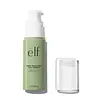What's inside
What's inside
 Key Ingredients
Key Ingredients

 Benefits
Benefits

No benefits
 Concerns
Concerns

 Ingredients Side-by-side
Ingredients Side-by-side

Water
Skin ConditioningMethyl Trimethicone
Skin ConditioningPropanediol
SolventGlycerin
HumectantCetyl Ethylhexanoate
EmollientButylene Glycol
HumectantPentylene Glycol
Skin Conditioning1,2-Hexanediol
Skin ConditioningMica
Cosmetic ColorantGlycereth-26
HumectantCI 77891
Cosmetic ColorantLitchi Chinensis Fruit Extract
Skin ConditioningPsidium Guajava Fruit Extract
AstringentCarica Papaya Fruit Extract
Skin ConditioningChlorella Vulgaris Extract
Skin ConditioningTin Oxide
AbrasivePEG-100 Stearate
Hdi/Trimethylol Hexyllactone Crosspolymer
Potassium Cetyl Phosphate
EmulsifyingSorbitan Oleate
EmulsifyingSorbitan Olivate
EmulsifyingSorbitan Sesquioleate
EmulsifyingGlucose
HumectantFructooligosaccharides
HumectantFructose
HumectantGlyceryl Stearate
EmollientTrideceth-10
CleansingTriethoxycaprylylsilane
Cetearyl Olivate
Isohexadecane
EmollientSodium Acrylate/Sodium Acryloyldimethyl Taurate Copolymer
Emulsion StabilisingSodium Polyacrylate
AbsorbentSodium Polyacryloyldimethyl Taurate
Emulsion StabilisingSilica
AbrasiveCarica Papaya Fruit Water
Skin ConditioningAluminum Hydroxide
EmollientHydrogenated Polydecene
EmollientCitric Acid
BufferingTrisodium Ethylenediamine Disuccinate
Synthetic Fluorphlogopite
Ethylhexylglycerin
Skin ConditioningPolysorbate 80
EmulsifyingPotassium Sorbate
PreservativeSodium Benzoate
MaskingPhenoxyethanol
PreservativeCI 77491
Cosmetic ColorantCI 77492
Cosmetic ColorantParfum
MaskingWater, Methyl Trimethicone, Propanediol, Glycerin, Cetyl Ethylhexanoate, Butylene Glycol, Pentylene Glycol, 1,2-Hexanediol, Mica, Glycereth-26, CI 77891, Litchi Chinensis Fruit Extract, Psidium Guajava Fruit Extract, Carica Papaya Fruit Extract, Chlorella Vulgaris Extract, Tin Oxide, PEG-100 Stearate, Hdi/Trimethylol Hexyllactone Crosspolymer, Potassium Cetyl Phosphate, Sorbitan Oleate, Sorbitan Olivate, Sorbitan Sesquioleate, Glucose, Fructooligosaccharides, Fructose, Glyceryl Stearate, Trideceth-10, Triethoxycaprylylsilane, Cetearyl Olivate, Isohexadecane, Sodium Acrylate/Sodium Acryloyldimethyl Taurate Copolymer, Sodium Polyacrylate, Sodium Polyacryloyldimethyl Taurate, Silica, Carica Papaya Fruit Water, Aluminum Hydroxide, Hydrogenated Polydecene, Citric Acid, Trisodium Ethylenediamine Disuccinate, Synthetic Fluorphlogopite, Ethylhexylglycerin, Polysorbate 80, Potassium Sorbate, Sodium Benzoate, Phenoxyethanol, CI 77491, CI 77492, Parfum
 Reviews
Reviews

Ingredients Explained
These ingredients are found in both products.
Ingredients higher up in an ingredient list are typically present in a larger amount.
Ci 77492 is also hydrated iron III oxide. It's sole purpose is to give a yellow hue to products.
Iron III oxides are classified as inorganic chemicals for coloring.
Synthetically created Ci 77492 is considered safer than those naturally found. This is because the synthetically created version may contain less impurities. Iron oxides are generally non-toxic and non-allergenic.
Learn more about CI 77492Ci 77891 is a white pigment from Titanium dioxide. It is naturally found in minerals such as rutile and ilmenite.
It's main function is to add a white color to cosmetics. It can also be mixed with other colors to create different shades.
Ci 77891 is commonly found in sunscreens due to its ability to block UV rays.
Learn more about CI 77891Phenoxyethanol is a preservative that has germicide, antimicrobial, and aromatic properties. Studies show that phenoxyethanol can prevent microbial growth. By itself, it has a scent that is similar to that of a rose.
It's often used in formulations along with Caprylyl Glycol to preserve the shelf life of products.
Silica, also known as silicon dioxide, is a naturally occurring mineral. It is used as a fine, spherical, and porous powder in cosmetics.
Though it has exfoliant properties, the function of silica varies depending on the product.
The unique structure of silica enhances the spreadability and adds smoothness, making it a great texture enhancer.
It is also used as an active carrier, emulsifier, and mattifier due to its ability to absorb excess oil.
In some products, tiny microneedles called spicules are made from silica or hydrolyzed sponge. When you rub them in, they lightly polish away dead skin layers and enhance the penetration of active ingredients.
Learn more about Silica